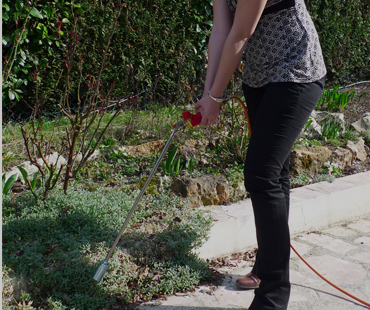
Utilizing a thermal weeder to eliminate weeds involves precise targeting to avoid indiscriminate plant damage, unlike chemical methods that often contaminate soil and groundwater. However, proper safety measures are crucial when handling a thermal weeder to safeguard both the user and the environment.
Personal protection for the thermal weeder operator
The use of a thermal weeder eradicates weeds by precisely targeting them. This device is far more respectful than chemicals, which kill all plants indiscriminately before seeping into the soil and contaminating an entire area, including precious groundwater. However, handling a thermal weeder requires safety measures to prevent risks to both the user and the environment.
When using a thermal weeder, you’ll need to wear appropriate clothing for working on terrain that may be uneven, with vegetation that could injure you, such as brambles or nettles. You also need to protect yourself against burns from the flame emanating from the thermal weeder.
We therefore recommend that you wear pants, not shorts or Bermuda shorts, as well as safety shoes and protective gloves. All your clothing must be made of fire-retardant fibers: intrinsically flame-retardant modacrylic, aramid fibers like Kevlar or Nomex resistant to very high temperatures, flame-retardant cotton or polyester, etc.
Safety precautions when using a thermal weeder
Always refer to the manufacturer’s instructions for specific details about your thermal weeder. However, here are general safety guidelines applicable to all models:
• Never operate a device with damaged or worn seals.
• Prior to use, inspect the thermal weeder, focusing on the gas hose and regulator for models using a cylinder, or ensuring gas cartridges are securely fastened.
• Avoid using a leaking, damaged, or malfunctioning appliance.
• When attaching the container to the cylinder on a wheeled cart, ensure the gasket between the regulator and the gas container is present and in good condition.
• Change gas cartridges or cylinders in well-ventilated areas, preferably outdoors, away from any ignition sources.
• Maintain horizontal positioning of gas cylinders at all times.
• To check for gas leaks, move to an outdoor area away from ignition sources. The simplest and most effective method for detecting leaks is using soapy water.
• Never direct the thermal weeder towards people or animals.
• Avoid pointing the burner at the gas cylinder, gas hose, or any objects that could ignite or release harmful fumes.
• Always shut the gas cylinder valve after extended periods of inactivity.
• Follow the instructions for setting the flame on your thermal weeder.
Checking the terrain and the weather
Do not use the thermal weeder on excessively dry ground to prevent the risk of starting uncontrollable fires. Generally, avoid working in dry conditions. The device is unsuitable for brushy terrain; mowing the lawn prior to using the flame on weeds is recommended. Moreover, operating a thermal weeder in high winds is dangerous due to the increased fire risk.


